From the Editor – May 2023
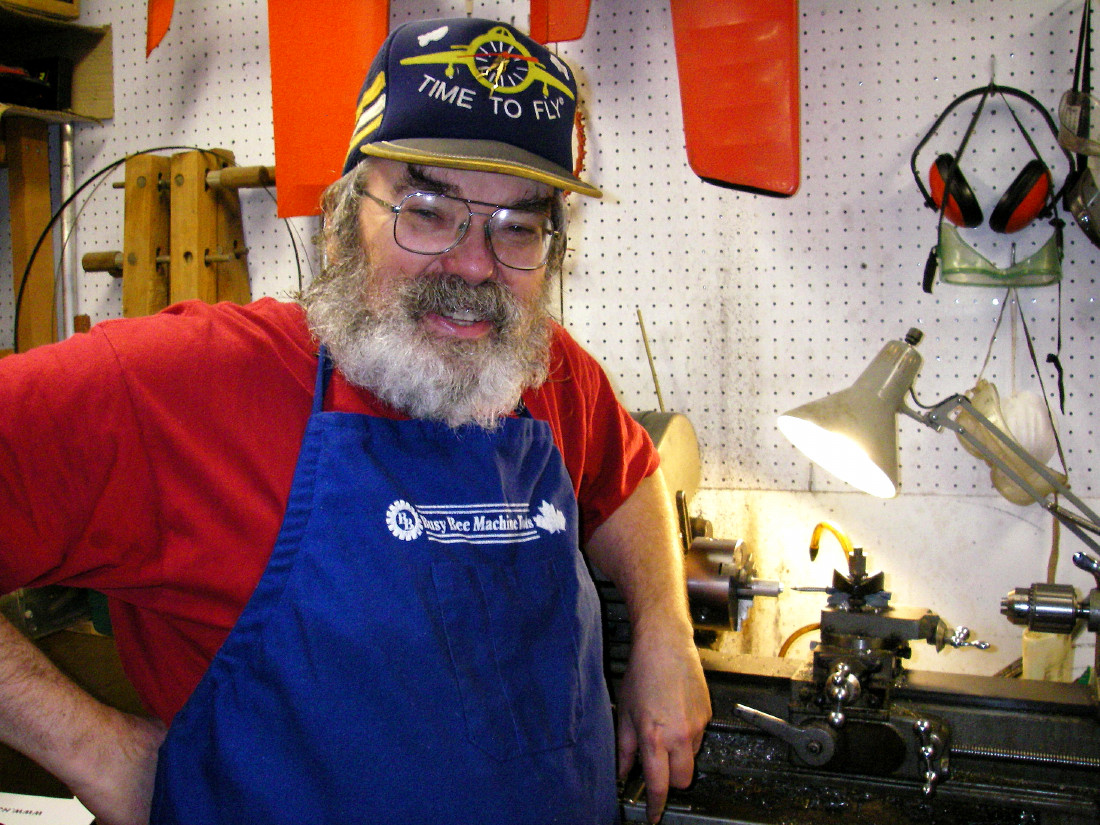 Greetings from Western Canada once more! Hooray, Hooray, the First of May, as the old school chant used to begin! I’m far too old to even fantasize about dancing around the Maypole, so I’ll have to be content with enjoying the improved weather that Spring is just now beginning to deliver.
Greetings from Western Canada once more! Hooray, Hooray, the First of May, as the old school chant used to begin! I’m far too old to even fantasize about dancing around the Maypole, so I’ll have to be content with enjoying the improved weather that Spring is just now beginning to deliver.
Here in BC we’re still somewhat short on our water reserves to get us through the coming summer. Although there has recently been a bit of rain here and there between the increasingly frequent sunny periods, the biggest concern is snowpack. We have considerably less than usual, while the expected elevated temperatures will cause what there is to melt and run off relatively quickly instead of being spread out over the summer months to keep our reservoirs supplied.
Sadly, the global situation has not improved. It would be easy to fall victim to despair in the face of the present levels of international political and societal dysfunction which threaten us all. However, that wouldn’t solve anything. Looking at the situation pragmatically, I reckon that all we can do as individuals is carry on as best we’re able while exercising due caution and responsibility in those areas which remain within our control, which is what I’m doing. It really does help to know that there’s still an ongoing interest in model engines among my valued readers - that’s what keeps me going! My statistics reporting system has continued to report very encouraging visitation figures.
 Confirmation that a significant number of folks are seeking an escape from all that ails us by remaining very much engaged with our hobby comes from the fact that the mail box has remained quite active. Despite the many distractions now preying upon us, I still heard from quite a few of you during April, including (in no particular order) Peter Valicek, Don Imrie, Dave Zwolak, Ted Smith, Bob Allan, Luis Petersen, Bo Sandström, Maris Dislers, Lars Gustafsson, Andrew Boddington, Jim Woodside, Peter Rathke, Pat Hardy, Ladislav Kulhavý, Oldřich Palasman, Gordon Beeby, Hugh Blowers, Fred Burman, Tim Dannels, Miles Patience, Cole Young and Neill McRae. Apologies to anyone whom I may have inadvertently missed in the crowd, and apologies also to anyone whose message(s) went unanswered - things do slip through the cracks, especially when I’m distracted! The blog site has continued to justify its existence by contributing a small but steady flow of relevant traffic - thanks for that.
Confirmation that a significant number of folks are seeking an escape from all that ails us by remaining very much engaged with our hobby comes from the fact that the mail box has remained quite active. Despite the many distractions now preying upon us, I still heard from quite a few of you during April, including (in no particular order) Peter Valicek, Don Imrie, Dave Zwolak, Ted Smith, Bob Allan, Luis Petersen, Bo Sandström, Maris Dislers, Lars Gustafsson, Andrew Boddington, Jim Woodside, Peter Rathke, Pat Hardy, Ladislav Kulhavý, Oldřich Palasman, Gordon Beeby, Hugh Blowers, Fred Burman, Tim Dannels, Miles Patience, Cole Young and Neill McRae. Apologies to anyone whom I may have inadvertently missed in the crowd, and apologies also to anyone whose message(s) went unanswered - things do slip through the cracks, especially when I’m distracted! The blog site has continued to justify its existence by contributing a small but steady flow of relevant traffic - thanks for that.
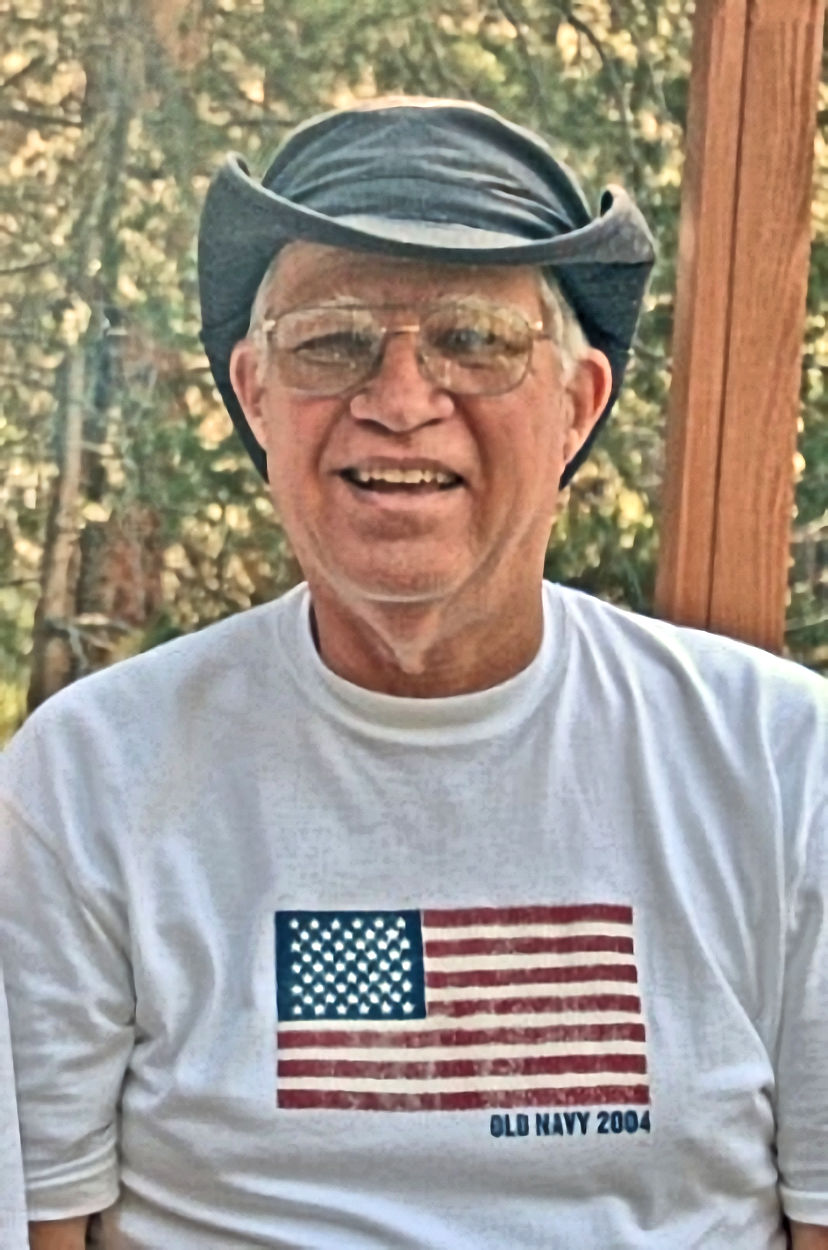 There’s a lot to talk about this month, so I’d best get to it! Sady, I have to begin this month’s news announcements by reporting yet another departure from among our community. My fellow model engine historian Jim Dunkin (left) passed away on Tuesday April 25th, 2023. Many of my fellow enthusiasts will know Jim as the author of the invaluable "Reference Book of .15 ci/2.5 cc Model Airplane Engines" as well as his definitive history of the Dennymite and related ventures entitled "Dennymites, Drones and More - a Biography of Walter H. Righter, Engineer/Inventor". Fewer people seem to know that at one time Jim was a very capable competitor in FAI control-line team racing at the International level, representing the USA on a number of occasions.
There’s a lot to talk about this month, so I’d best get to it! Sady, I have to begin this month’s news announcements by reporting yet another departure from among our community. My fellow model engine historian Jim Dunkin (left) passed away on Tuesday April 25th, 2023. Many of my fellow enthusiasts will know Jim as the author of the invaluable "Reference Book of .15 ci/2.5 cc Model Airplane Engines" as well as his definitive history of the Dennymite and related ventures entitled "Dennymites, Drones and More - a Biography of Walter H. Righter, Engineer/Inventor". Fewer people seem to know that at one time Jim was a very capable competitor in FAI control-line team racing at the International level, representing the USA on a number of occasions.
Jim very much shared my personal view that the long-term preservation of classic model engines requires that they be fully documented and that their history be preserved. He made an immense contribution to that field. He was unfailing in his support and assistance in connection with my work on this website. I'll miss him, as will many others..................an obituary may be found here.
Unfortunately, I have to continue by reporting yet another website problem to be resolved. Readers will recall my recent difficulties with access to my website. That issue has been resolved through a comprehensive upgrade of my entire system, but now a new difficulty has arisen – the “Add  Attachments” function in my website's administrative system has suddenly become really picky about uploading and storing files to which links can be created. In particular, it seems to have taken a strong dislike to pdf files. As a result, some of the links in my “Publications” and Technical Topics” sections have either failed or disappeared completely. I still have all the material stored on my own computer, so nothing's lost. I’m trying to get this sorted, but in the meantime you’ll just have to bear with me! Most of the site still works fine – it’s just a few specific items that have gone AWOL. I’ll stay on the case …………
Attachments” function in my website's administrative system has suddenly become really picky about uploading and storing files to which links can be created. In particular, it seems to have taken a strong dislike to pdf files. As a result, some of the links in my “Publications” and Technical Topics” sections have either failed or disappeared completely. I still have all the material stored on my own computer, so nothing's lost. I’m trying to get this sorted, but in the meantime you’ll just have to bear with me! Most of the site still works fine – it’s just a few specific items that have gone AWOL. I’ll stay on the case …………
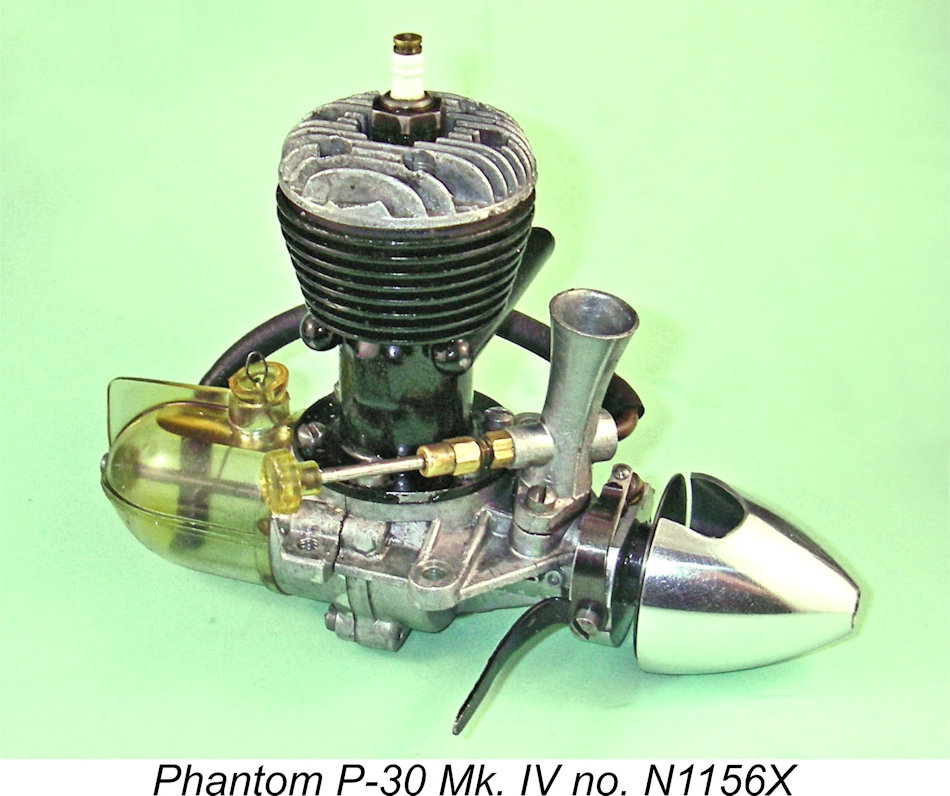 Now on to happier matters! Thanks to some splendid co-operation from my Aussie mate Ted Smith, I was provided with a nice running example of the 0.297 cuin. Phantom P-30 sparkie from Los Angeles, California. As usual, this started me off on a quest for information. Rather to my surprise, I learned that Tim Dannels’ sadly now-discontinued “Engine Collector’s Journal” (ECJ) never ran a feature on this notable engine! This left it up to me to fill the information gap! I’ve made good progress on a review and test of the P-30, but could really use some more serial numbers. If you’re able to help in that regard, please get in touch! Meanwhile, the Phantom P-30 has been added to my “Gallery” section.
Now on to happier matters! Thanks to some splendid co-operation from my Aussie mate Ted Smith, I was provided with a nice running example of the 0.297 cuin. Phantom P-30 sparkie from Los Angeles, California. As usual, this started me off on a quest for information. Rather to my surprise, I learned that Tim Dannels’ sadly now-discontinued “Engine Collector’s Journal” (ECJ) never ran a feature on this notable engine! This left it up to me to fill the information gap! I’ve made good progress on a review and test of the P-30, but could really use some more serial numbers. If you’re able to help in that regard, please get in touch! Meanwhile, the Phantom P-30 has been added to my “Gallery” section.
Testing the Phantom (which performed flawlessly) gave me the nudge that I needed to finally conduct a sparkie testing session  which I’ve been putting off for years – the very rare Pinotti GP and JP 7.5 cc units from pre-WW2 Sweden. Long-time readers may remember my in-depth article about the life and work of Giancarlo Pinotti, the multi-talented Italian who emigrated to Sweden and became that country’s first commercial model engine manufacturer in 1938. His 7.5 cc spark ignition units were the first designs on offer, remaining in limited production until 1943, at which time Pinotti re-directed his attention to diesels.
which I’ve been putting off for years – the very rare Pinotti GP and JP 7.5 cc units from pre-WW2 Sweden. Long-time readers may remember my in-depth article about the life and work of Giancarlo Pinotti, the multi-talented Italian who emigrated to Sweden and became that country’s first commercial model engine manufacturer in 1938. His 7.5 cc spark ignition units were the first designs on offer, remaining in limited production until 1943, at which time Pinotti re-directed his attention to diesels.
When that article was first published in June 2015, I had yet to get to grips with what I then saw as the somewhat mysterious business of running sparkies. That only happened in early 2019, when I finally bit the bullet and equipped myself to run these fine old classics, 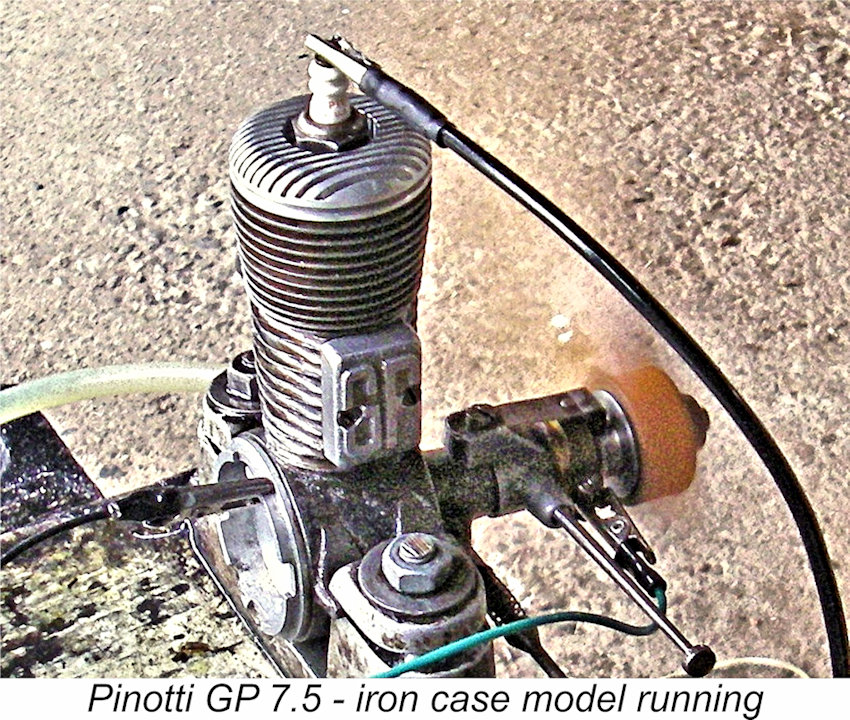 surprising myself by finding out how completely straightforward their operation actually is! The resulting “how-to” article may be found here. Read it and have a go for yourself – a whole new world of fun awaits!
surprising myself by finding out how completely straightforward their operation actually is! The resulting “how-to” article may be found here. Read it and have a go for yourself – a whole new world of fun awaits!
Having sorted out a dependable spark ignition test system with the help of supplier Larry Davidson, a topic that immediately presented itself as a worthwhile project was a test of my two Pinotti 7.5 cc sparkies – a GP and a JP. However, one thing piled up upon another, and I never seemed to get around to it. The testing of the Phantom P-30 was the trigger which finally stimulated me into making good on my long-nursed intention, which I did during the past month. Both engines performed splendidly after their eighty-plus years on the shelf, doing great credit to their manufacturer. I’ve added the results of this testing to my existing Pinotti article, which is finally complete after 8 years!
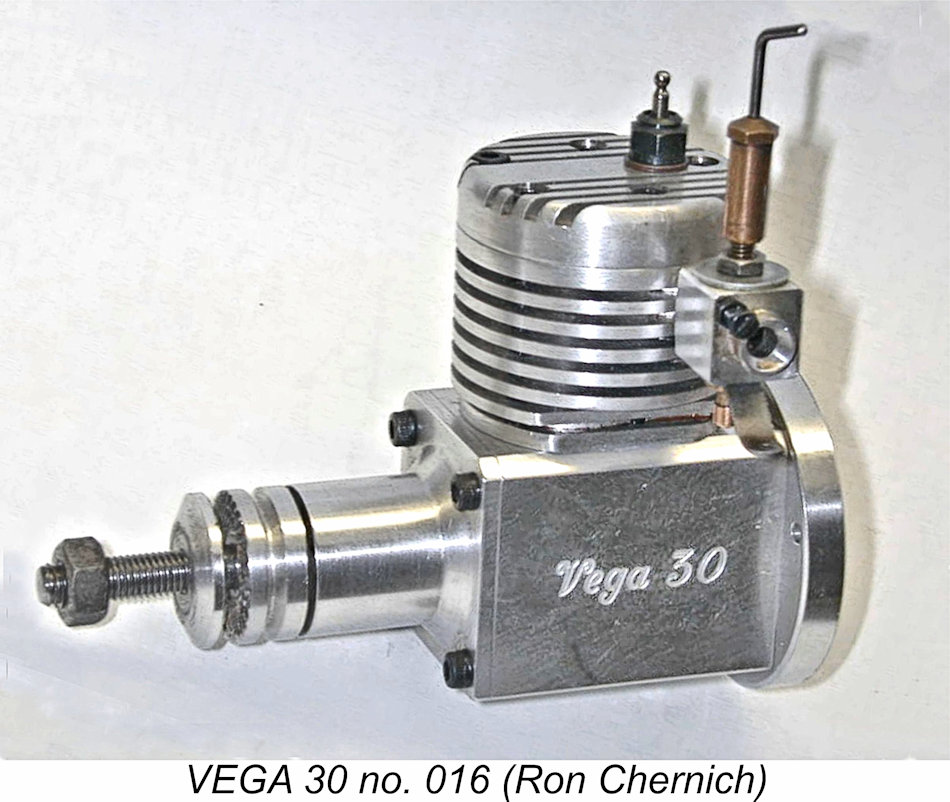 I was very pleased to receive some information from my good mate Don Imrie of Scotland regarding a somewhat under-appreciated range of unique British four-stroke engines which were individually hand-crafted and sold by John Harbone of Birmingham under the VEGA name between 1989 and 1994. I use the term “unique” because the commercial renditions of these engines were side-valve designs as opposed to the usual OHV offerings – the “Briggs & Stratton” units of the modelling world! Despite using this generally less efficient valve technology, the VEGA engines were superbly-made, fine-handling, extremely quiet and completely dependable model powerplants which performed at a fully adequate level for R/C sport and scale flying.
I was very pleased to receive some information from my good mate Don Imrie of Scotland regarding a somewhat under-appreciated range of unique British four-stroke engines which were individually hand-crafted and sold by John Harbone of Birmingham under the VEGA name between 1989 and 1994. I use the term “unique” because the commercial renditions of these engines were side-valve designs as opposed to the usual OHV offerings – the “Briggs & Stratton” units of the modelling world! Despite using this generally less efficient valve technology, the VEGA engines were superbly-made, fine-handling, extremely quiet and completely dependable model powerplants which performed at a fully adequate level for R/C sport and scale flying.
Don has shared his personal experiences of these engines, while I was able to add to the story through reference to some information on the VEGA range which is still to be found on the late Ron Chernich’s now-frozen “Model Engine News” (MEN) website. A detailed article on the VEGA engines will appear in due course on this website. Meanwhile, I’ve added a VEGA entry to the “Gallery” listings.
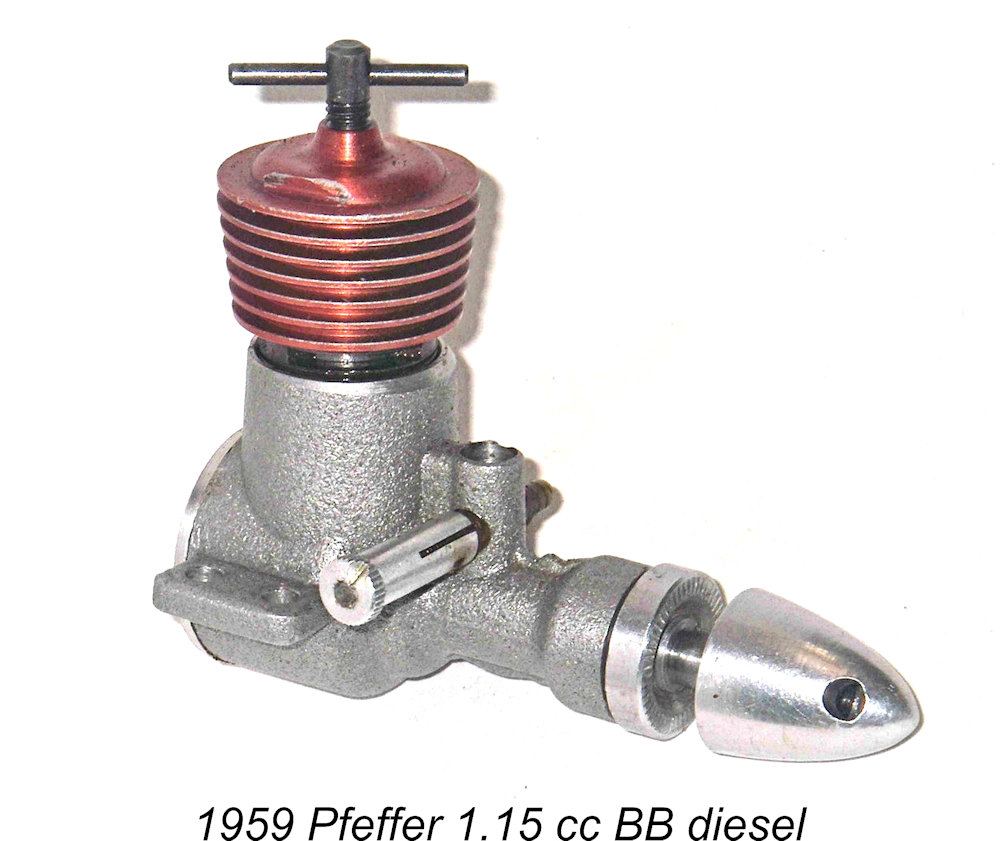 During the past month I was reminded yet again that it’s a rare collector who has complete and accurate information about every item in his own collection! I certainly don’t, and I received a reminder of this thanks to a contact brokered by Maris Dislers with a group of enthusiasts in the Czech Republic in connection with a forthcoming article on the Pfeffer 0.6 cc diesels (see below). Having established communication with these gentlemen, I decided to send them an image of a well-made 1.15 cc twin ball-race diesel which has been languishing in my collection for decades – I can’t even recall how I acquired it! I had been told by the previous owner that it was made by Josef Pfeffer of Brno and that it was quite rare, but he couldn’t tell me any more. I didn’t even have a date ………..
During the past month I was reminded yet again that it’s a rare collector who has complete and accurate information about every item in his own collection! I certainly don’t, and I received a reminder of this thanks to a contact brokered by Maris Dislers with a group of enthusiasts in the Czech Republic in connection with a forthcoming article on the Pfeffer 0.6 cc diesels (see below). Having established communication with these gentlemen, I decided to send them an image of a well-made 1.15 cc twin ball-race diesel which has been languishing in my collection for decades – I can’t even recall how I acquired it! I had been told by the previous owner that it was made by Josef Pfeffer of Brno and that it was quite rare, but he couldn’t tell me any more. I didn’t even have a date ………..
It turned out that I had a real rarity of some historical significance! I received an account written by Jaromír Pipek in which he recalled buying one of these engines in late 1959, thus establishing the engine’s date. He confirmed that it was indeed made by Josef Pfeffer and that only 5 examples were ever made due to difficulties in obtaining the required ball bearings. Rare indeed – I had no idea! A timely reminder of the importance of accurately 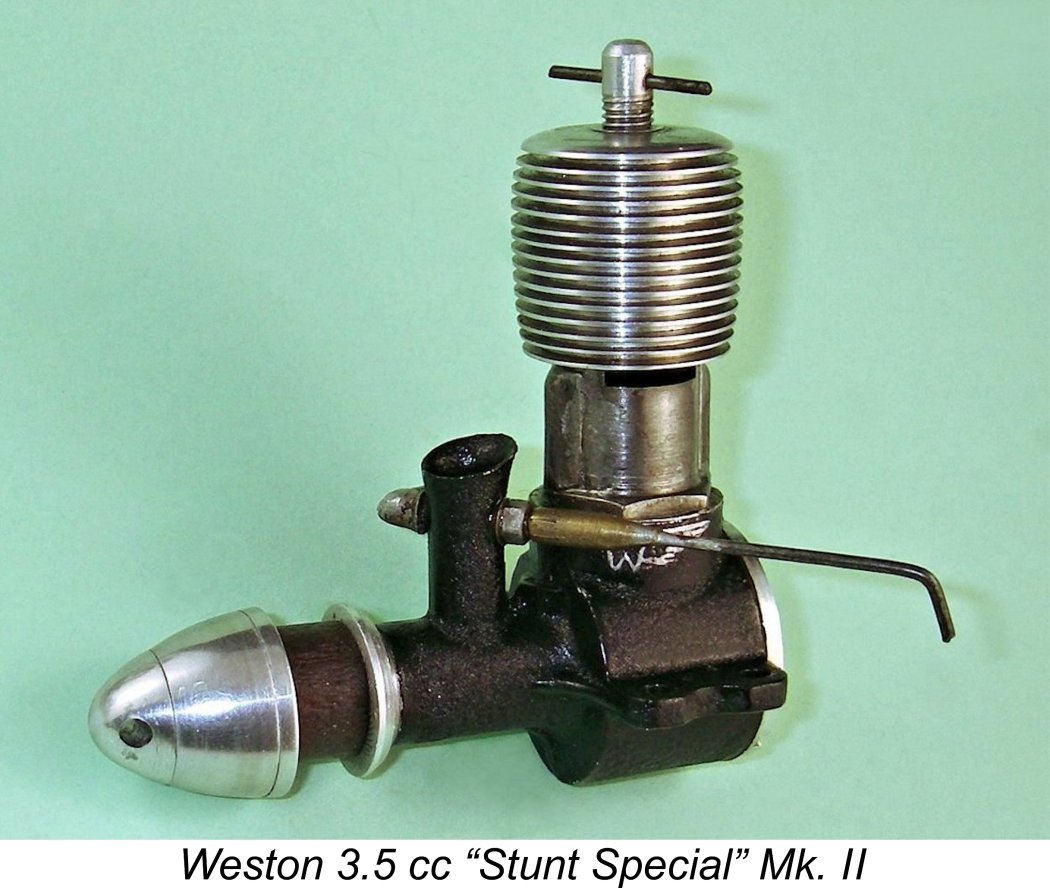 identifying the items in your collection – some of them may be more significant than you might otherwise realize!
identifying the items in your collection – some of them may be more significant than you might otherwise realize!
My good mate Gordon Beeby of Australia came up with an interesting topic for idle speculation! He found entries in the “Club News” features of the December 1950 issues of both “Aeromodeller” and "Model Aircraft" which reported that Southampton M.A.C. member Peter Cock (the 1948 Gold Trophy winner) had won a club “engine starting competition” using his Weston 3.5 cc diesel (probably a “Stunt Special”). Peter’s winning times were 18 seconds from cold and 7½ seconds when hot.
These times are pretty slow when compared with my personal experiences with the Weston, which is a dependable one- or two-flick starter hot or cold once set and primed. Moreover, they're glacial by Mills standards! However, the "Model Aircraft" report confirmed that filling the tank (presumably the same tank for each contestant) was part of the timed starting procedure, as were any necessary choking and priming. It also confirmed that once fuelled, the Weston was a one-flick starter! Between us, Gordon and I came up with the following potential format:
- Begin with cold "dry" engine of entrant’s choice and empty tank.
- Start timing with master stopwatch. GO!!
- Fuel and start engine, choking and priming as necessary.
- Once started, run for a specified minimum time (run timed with a second stopwatch)
- Stop engine by specified means (cut-out, rag-in-prop, fuel line pinch, or ……?!?) and stop second stopwatch.
- Immediately restart (restart second stopwatch once running again)
- Run for a further specified minimum time (timed with second stopwatch)
- Stop engine when second stopwatch indicates that the required cumulative time for both runs has been achieved.
- Stop master stopwatch once the prop stops turning at the end of the second minimum
- Lowest total time on master stopwatch wins!
The minimum run times would be necessary to prevent under-filling to save time. Keys to success would include a quick fuelling system as well as saving time by fuelling only just enough to complete the two runs. Running fairly lean on a big prop would minimize fuel requirements. Gordon and I can see the potential for a fun club activity here! The range of possible formats is endless...............
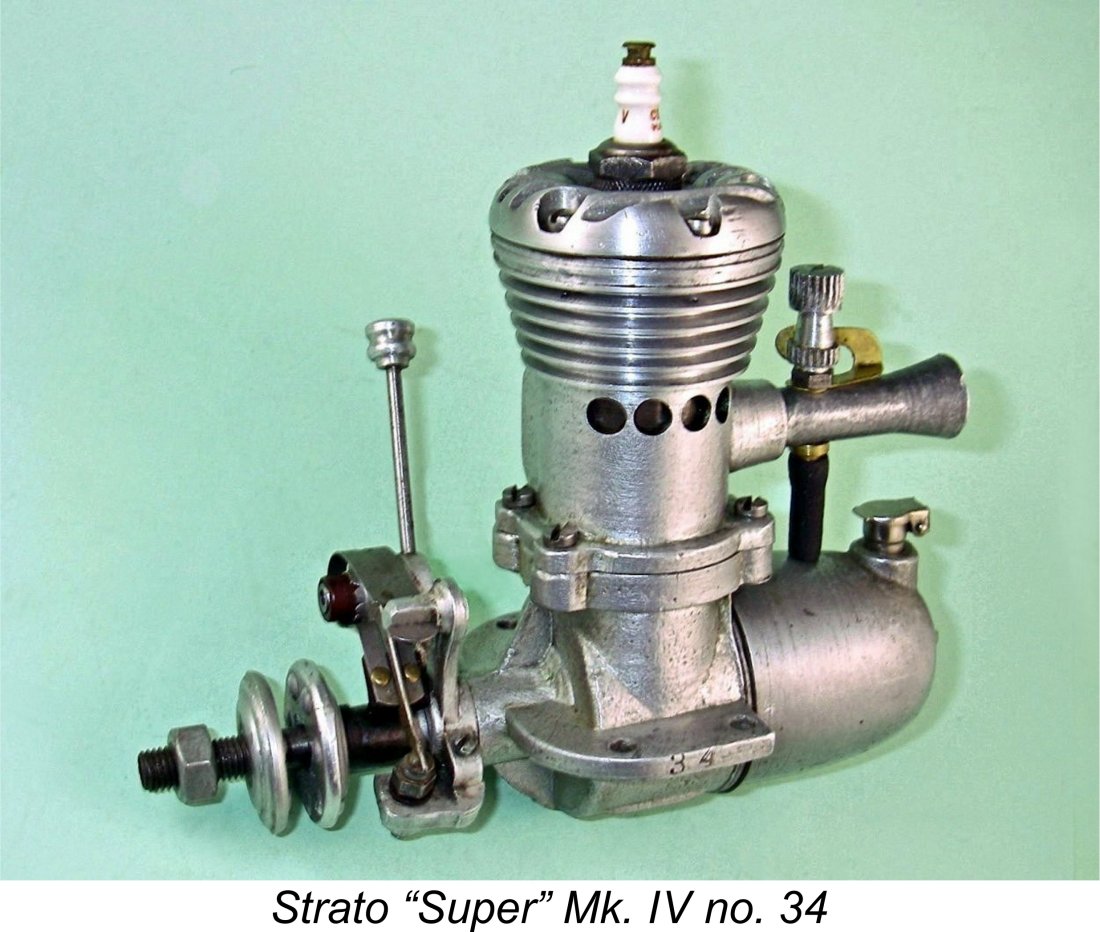 Turning now to this month’s lead articles, I have yet another triple-header for you - two all-original articles and one MEN transfer effort! The first of the all-new articles sees us returning to my adopted country of Canada to continue my efforts to fully document the limited number of model engine ranges originating in that country. I already wrote about the Queen Bee, Monarch 600, Banshee .604 and Hurricane engines. Time now to turn attention towards one of the less prolific but most notable Canadian ranges – the Strato series from Montreal.
Turning now to this month’s lead articles, I have yet another triple-header for you - two all-original articles and one MEN transfer effort! The first of the all-new articles sees us returning to my adopted country of Canada to continue my efforts to fully document the limited number of model engine ranges originating in that country. I already wrote about the Queen Bee, Monarch 600, Banshee .604 and Hurricane engines. Time now to turn attention towards one of the less prolific but most notable Canadian ranges – the Strato series from Montreal.
The Strato engines were individually constructed to very high standards by British-born Montreal resident Randall Bainbridge, who completed some 80 units between 1940 and 1947. Most of these were spark ignition models, although a single diesel prototype was completed. The surviving engines are a testament to the model engineering skill of their very talented creator. Their story is well worth preserving.
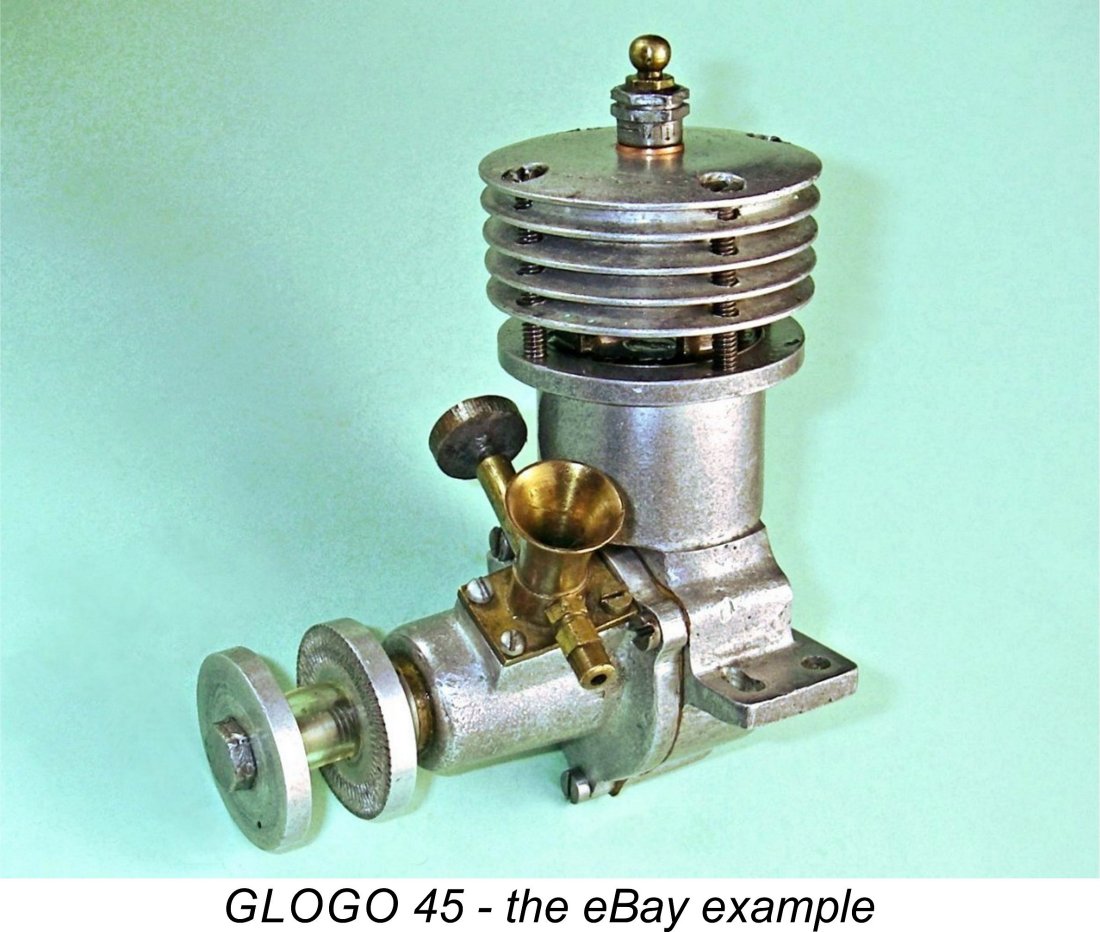 The second all-new article is one which I wasn’t expecting to publish this month. However, circumstances arose which allowed me to finish it, so I may as well get it out there! This one’s as much a plea for information from readers as it is a full review of a given engine. This is because so little is known about it! I’m referring to a mysterious 0.45 cuin. glow-plug motor called the GLOGO 45.
The second all-new article is one which I wasn’t expecting to publish this month. However, circumstances arose which allowed me to finish it, so I may as well get it out there! This one’s as much a plea for information from readers as it is a full review of a given engine. This is because so little is known about it! I’m referring to a mysterious 0.45 cuin. glow-plug motor called the GLOGO 45.
I acquired an example of this seemingly extremely rare engine through eBay, subsequently acquiring a second variant through the good graces of a friend in England. The GLOGO’s design features and dimensions strongly suggest a British origin during the early glow-plug era, but that’s as far as I can go. I have clutched at a straw in the wind which suggests a possible London origin in late 1948, but it’s no more than a vague possibility. All that I’ve been able to do with any authority is describe the engines and bench-test them. It’s my hope that by presenting this information I may trigger a memory or two among my readership. If you can add to the story, please get in touch!
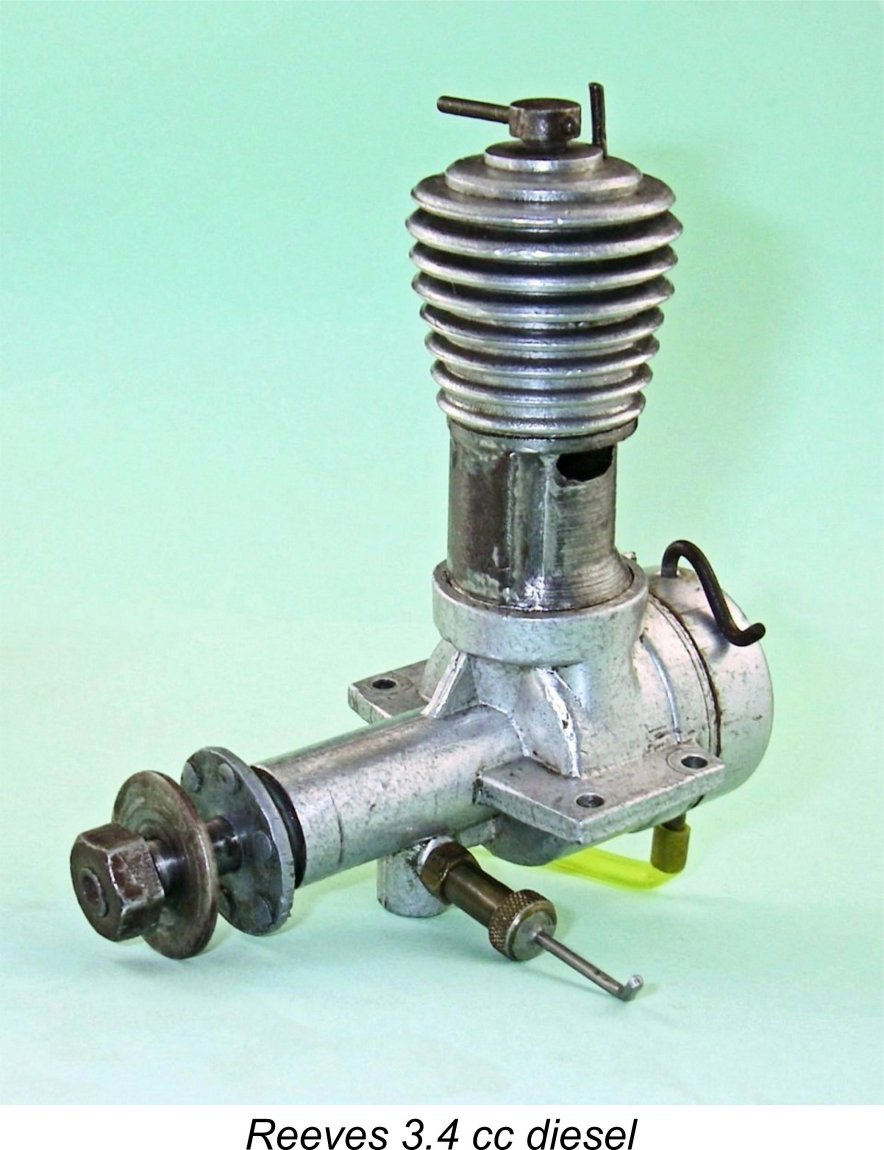 The MEN transfer article moves me one further step closer to the completion of my coverage on this website of the Reeves engines from Shifnal in Shropshire, England. I already dealt with the Reeves 6 cc spark ignition model with which Edward Reeves entered the model engine manufacturing field in 1946. Time now to take a good look at the successor to that design, the early 1948 Reeves 3.4 cc diesel with which Reeves made his debut in the model diesel field. That unit forms the subject of this month’s MEN transfer article. Updated articles on the later Reeves offerings will follow in due course.
The MEN transfer article moves me one further step closer to the completion of my coverage on this website of the Reeves engines from Shifnal in Shropshire, England. I already dealt with the Reeves 6 cc spark ignition model with which Edward Reeves entered the model engine manufacturing field in 1946. Time now to take a good look at the successor to that design, the early 1948 Reeves 3.4 cc diesel with which Reeves made his debut in the model diesel field. That unit forms the subject of this month’s MEN transfer article. Updated articles on the later Reeves offerings will follow in due course.
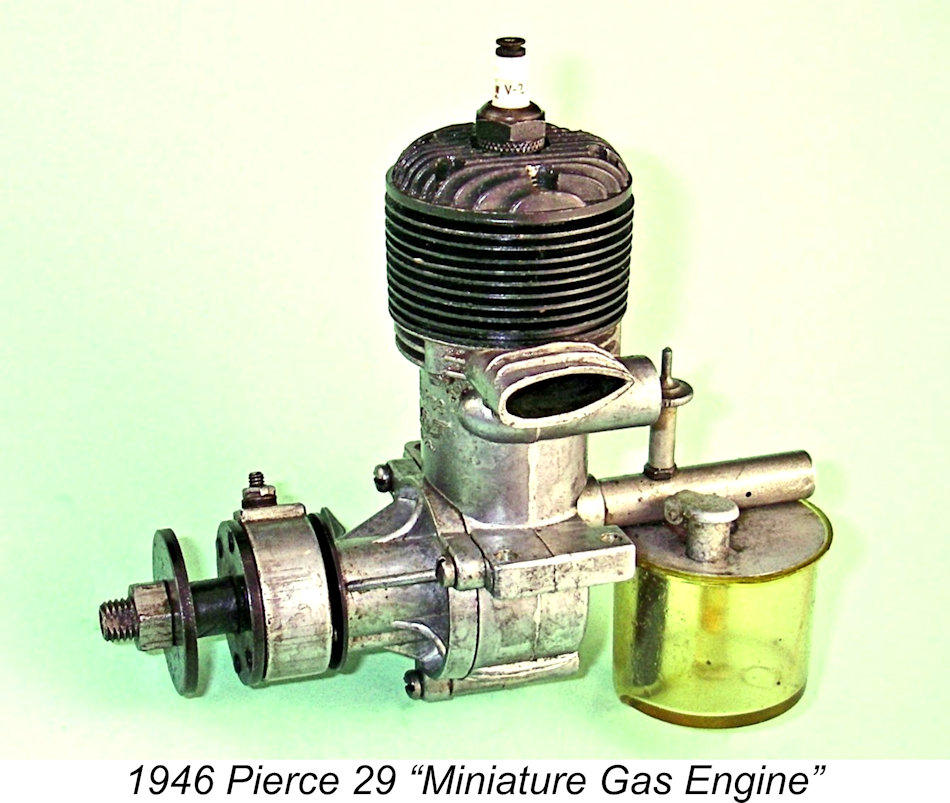 Next month will see yet another triple-header thanks yet again to some enthusiastic support from a friend and colleague. To begin with, I’ll present my own all-new article covering the history of one of the more obscure ranges from America – the Pierce 29 series from Chicago, Illinois.
Next month will see yet another triple-header thanks yet again to some enthusiastic support from a friend and colleague. To begin with, I’ll present my own all-new article covering the history of one of the more obscure ranges from America – the Pierce 29 series from Chicago, Illinois.
This short-lived range appears to have had some connection with the far better-known Forster marque, also from Chicago, but the exact nature of that connection is obscure. All that can be said is that there’s an untold story there ………. I’ve discussed the possibilities, described the engines and subjected them to bench tests, finding them to be well-made units which were very acceptable performers by the standards of their day. Their story is well worth preserving!
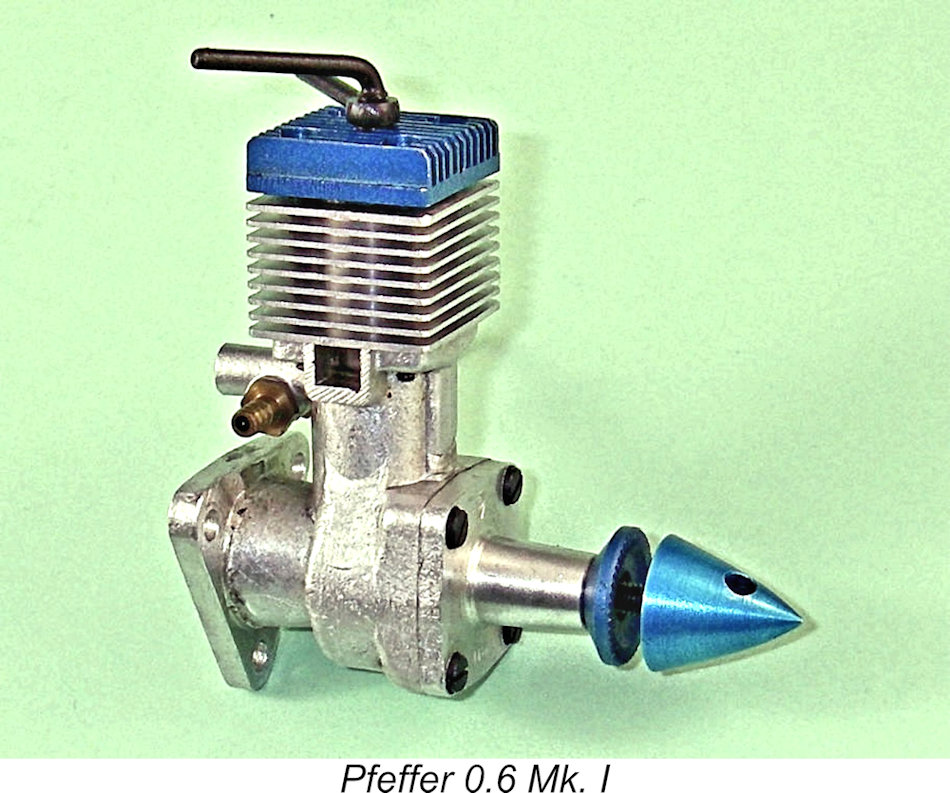 The bonus article for next month will come to you once more courtesy of my good mate Maris Dislers, who has undertaken some comparative testing of the various 0.6 cc diesels designed, and in some cases constructed, by Josef Pfeffer of Brno, Czechoslovakia (now the Czech Republic). These extremely well-made little engines are quite well-known among model engine aficionados, and Maris has done his usual fine job of providing some very useful comparative data on the handling and performance of some representative examples.
The bonus article for next month will come to you once more courtesy of my good mate Maris Dislers, who has undertaken some comparative testing of the various 0.6 cc diesels designed, and in some cases constructed, by Josef Pfeffer of Brno, Czechoslovakia (now the Czech Republic). These extremely well-made little engines are quite well-known among model engine aficionados, and Maris has done his usual fine job of providing some very useful comparative data on the handling and performance of some representative examples.
As mentioned earlier, Maris also put me in 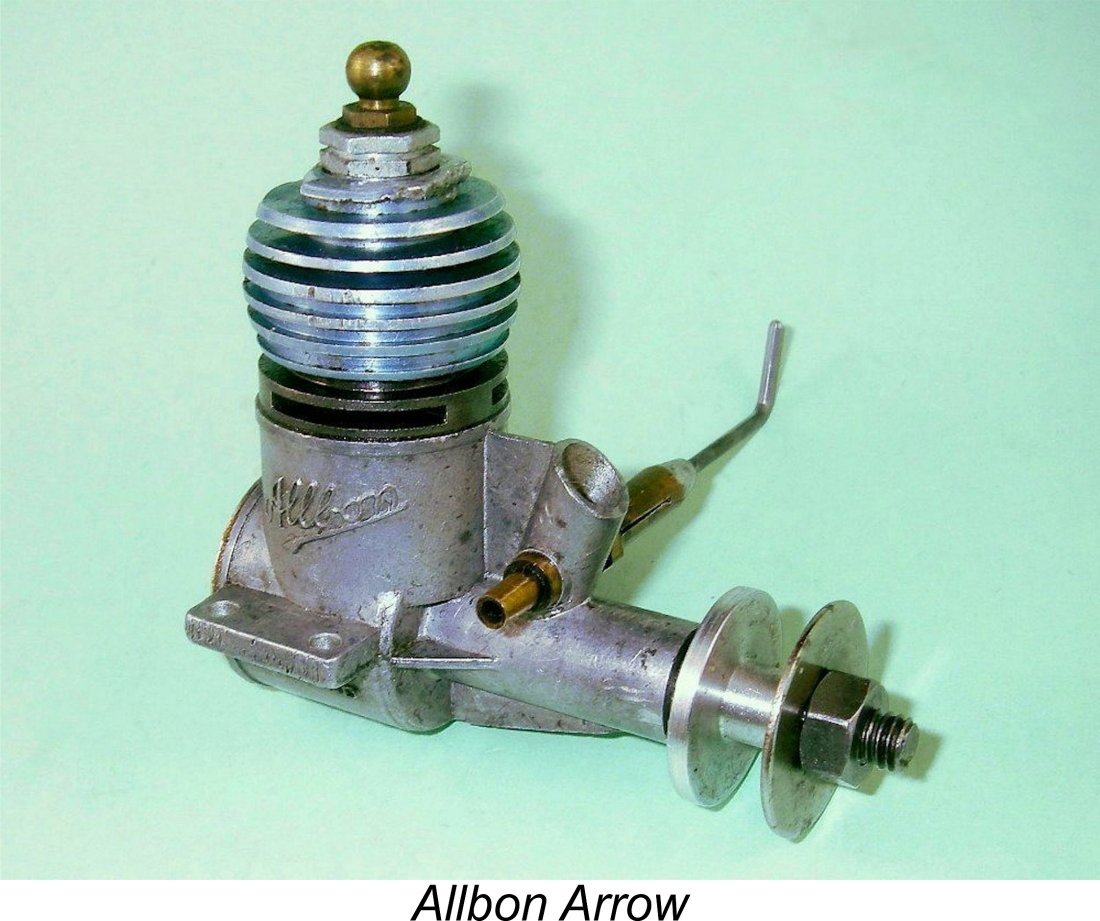 touch with a group of Czech enthusiasts, most notably Jaromír Pipek, who provided a highly informative summary of the entire Pfeffer 0.6 cc series from start to finish. This complemented Maris’s efforts perfectly, and I think that you’ll enjoy the combined text and photos as much as I did!
touch with a group of Czech enthusiasts, most notably Jaromír Pipek, who provided a highly informative summary of the entire Pfeffer 0.6 cc series from start to finish. This complemented Maris’s efforts perfectly, and I think that you’ll enjoy the combined text and photos as much as I did!
The MEN transfer article for June will be the follow-up to my earlier piece on the subject of the Allbon 2.8 diesel. I’ll carry the story of the early Allbon models forward into the rotary valve era, covering the Allbon FRV models from their late 1949 introduction up to the point at which circumstances forced Alan Allbon to abandon his own workshop and join forces with Davies-Charlton.
I think that about does it for this edition. All being well, I'll be back to you with another edition on or about June 1st, 2023. Meanwhile, please accept my best wishes for continuing the process of learning to live with the various challenges which now beset us so as to get the best of what life still has to offer under present circumstances. Take care and stay well - keep yourself informed from credible sources and trust your own informed opinions rather than the fantasies of others whose focus is entirely on themselves and their own agendas. Ignore them and the misinformation that they spread, make up your own mind based on authoritative current information and act accordingly! It’s your future and that of your kids and grand-kids .………. don’t let others having conflicting self-centred agendas decide it for you and for them!
Cheers,
Adrian Duncan
British Columbia, Canada
___________________________________
Note regarding material to be found on this site - unless specifically otherwise noted, all images and text which appear on this site are my own work, and I hereby assert my right to be recognized as the originator of this material. For the record, this material is made freely available to all upon two firm conditions:
- No commercial use of any kind is to be made of any of the images or text posted on this site without my express written consent.
- No use of any kind, commercial or otherwise, is to be made of any material published in any form on this site without full and open acknowledgement of the source.
Adrian C. Duncan
British Columbia, Canada

 Greetings from Western Canada once more! Hooray, Hooray, the First of May, as the old school chant used to begin! I’m far too old to even fantasize about dancing around the Maypole, so I’ll have to be content with enjoying the improved weather that Spring is just now beginning to deliver.
Greetings from Western Canada once more! Hooray, Hooray, the First of May, as the old school chant used to begin! I’m far too old to even fantasize about dancing around the Maypole, so I’ll have to be content with enjoying the improved weather that Spring is just now beginning to deliver.  Confirmation that a significant number of folks are seeking an escape from all that ails us by remaining very much engaged with our hobby comes from the fact that the mail box has remained quite active. Despite the many distractions now preying upon us, I still heard from quite a few of you during April, including (in no particular order)
Confirmation that a significant number of folks are seeking an escape from all that ails us by remaining very much engaged with our hobby comes from the fact that the mail box has remained quite active. Despite the many distractions now preying upon us, I still heard from quite a few of you during April, including (in no particular order)  There’s a lot to talk about this month, so I’d best get to it! Sady, I have to begin this month’s news announcements by reporting yet another departure from among our community. My fellow model engine historian Jim Dunkin (left) passed away on Tuesday April 25
There’s a lot to talk about this month, so I’d best get to it! Sady, I have to begin this month’s news announcements by reporting yet another departure from among our community. My fellow model engine historian Jim Dunkin (left) passed away on Tuesday April 25
 Now on to happier matters! Thanks to some splendid co-operation from my Aussie mate Ted Smith, I was provided with a nice running example of the 0.297 cuin. Phantom P-30 sparkie from Los Angeles, California. As usual, this started me off on a quest for information. Rather to my surprise, I learned that Tim Dannels’ sadly now-discontinued “
Now on to happier matters! Thanks to some splendid co-operation from my Aussie mate Ted Smith, I was provided with a nice running example of the 0.297 cuin. Phantom P-30 sparkie from Los Angeles, California. As usual, this started me off on a quest for information. Rather to my surprise, I learned that Tim Dannels’ sadly now-discontinued “

 I was very pleased to receive some information from my good mate Don Imrie of Scotland regarding a somewhat under-appreciated range of unique British four-stroke engines which were individually hand-crafted and sold by John Harbone of Birmingham under the VEGA name between 1989 and 1994. I use the term “unique” because the commercial renditions of these engines were side-valve designs as opposed to the usual OHV offerings – the “Briggs & Stratton” units of the modelling world! Despite using this generally less efficient valve technology, the VEGA engines were superbly-made, fine-handling, extremely quiet and completely dependable model powerplants which performed at a fully adequate level for R/C sport and scale flying.
I was very pleased to receive some information from my good mate Don Imrie of Scotland regarding a somewhat under-appreciated range of unique British four-stroke engines which were individually hand-crafted and sold by John Harbone of Birmingham under the VEGA name between 1989 and 1994. I use the term “unique” because the commercial renditions of these engines were side-valve designs as opposed to the usual OHV offerings – the “Briggs & Stratton” units of the modelling world! Despite using this generally less efficient valve technology, the VEGA engines were superbly-made, fine-handling, extremely quiet and completely dependable model powerplants which performed at a fully adequate level for R/C sport and scale flying. During the past month I was reminded yet again that it’s a rare collector who has complete and accurate information about every item in his own collection! I certainly don’t, and I received a reminder of this thanks to a contact brokered by Maris Dislers with a group of enthusiasts in the Czech Republic in connection with a forthcoming article on the Pfeffer 0.6 cc diesels (see below). Having established communication with these gentlemen, I decided to send them an image of a well-made 1.15 cc twin ball-race diesel which has been languishing in my collection for decades – I can’t even recall how I acquired it! I had been told by the previous owner that it was made by Josef Pfeffer of Brno and that it was quite rare, but he couldn’t tell me any more. I didn’t even have a date ………..
During the past month I was reminded yet again that it’s a rare collector who has complete and accurate information about every item in his own collection! I certainly don’t, and I received a reminder of this thanks to a contact brokered by Maris Dislers with a group of enthusiasts in the Czech Republic in connection with a forthcoming article on the Pfeffer 0.6 cc diesels (see below). Having established communication with these gentlemen, I decided to send them an image of a well-made 1.15 cc twin ball-race diesel which has been languishing in my collection for decades – I can’t even recall how I acquired it! I had been told by the previous owner that it was made by Josef Pfeffer of Brno and that it was quite rare, but he couldn’t tell me any more. I didn’t even have a date ………..
 Turning now to this month’s lead articles, I have yet another triple-header for you - two all-original articles and one MEN transfer effort! The first of the all-new articles sees us returning to my adopted country of Canada to continue my efforts to fully document the limited number of model engine ranges originating in that country. I already wrote about the
Turning now to this month’s lead articles, I have yet another triple-header for you - two all-original articles and one MEN transfer effort! The first of the all-new articles sees us returning to my adopted country of Canada to continue my efforts to fully document the limited number of model engine ranges originating in that country. I already wrote about the  The second all-new article is one which I wasn’t expecting to publish this month. However, circumstances arose which allowed me to finish it, so I may as well get it out there! This one’s as much a plea for information from readers as it is a full review of a given engine. This is because so little is known about it! I’m referring to a mysterious 0.45 cuin. glow-plug motor called the
The second all-new article is one which I wasn’t expecting to publish this month. However, circumstances arose which allowed me to finish it, so I may as well get it out there! This one’s as much a plea for information from readers as it is a full review of a given engine. This is because so little is known about it! I’m referring to a mysterious 0.45 cuin. glow-plug motor called the  The MEN transfer article moves me one further step closer to the completion of my coverage on this website of the Reeves engines from Shifnal in Shropshire, England. I already dealt with the
The MEN transfer article moves me one further step closer to the completion of my coverage on this website of the Reeves engines from Shifnal in Shropshire, England. I already dealt with the  Next month will see yet another triple-header thanks yet again to some enthusiastic support from a friend and colleague. To begin with, I’ll present my own all-new article covering the history of one of the more obscure ranges from America – the Pierce 29 series from Chicago, Illinois.
Next month will see yet another triple-header thanks yet again to some enthusiastic support from a friend and colleague. To begin with, I’ll present my own all-new article covering the history of one of the more obscure ranges from America – the Pierce 29 series from Chicago, Illinois.  The bonus article for next month will come to you once more courtesy of my good mate Maris Dislers, who has undertaken some comparative testing of the various 0.6 cc diesels designed, and in some cases constructed, by Josef Pfeffer of Brno, Czechoslovakia (now the Czech Republic). These extremely well-made little engines are quite well-known among model engine aficionados, and Maris has done his usual fine job of providing some very useful comparative data on the handling and performance of some representative examples.
The bonus article for next month will come to you once more courtesy of my good mate Maris Dislers, who has undertaken some comparative testing of the various 0.6 cc diesels designed, and in some cases constructed, by Josef Pfeffer of Brno, Czechoslovakia (now the Czech Republic). These extremely well-made little engines are quite well-known among model engine aficionados, and Maris has done his usual fine job of providing some very useful comparative data on the handling and performance of some representative examples.  touch with a group of Czech enthusiasts, most notably Jaromír Pipek, who provided a highly informative summary of the entire Pfeffer 0.6 cc series from start to finish. This complemented Maris’s efforts perfectly, and I think that you’ll enjoy the combined text and photos as much as I did!
touch with a group of Czech enthusiasts, most notably Jaromír Pipek, who provided a highly informative summary of the entire Pfeffer 0.6 cc series from start to finish. This complemented Maris’s efforts perfectly, and I think that you’ll enjoy the combined text and photos as much as I did!